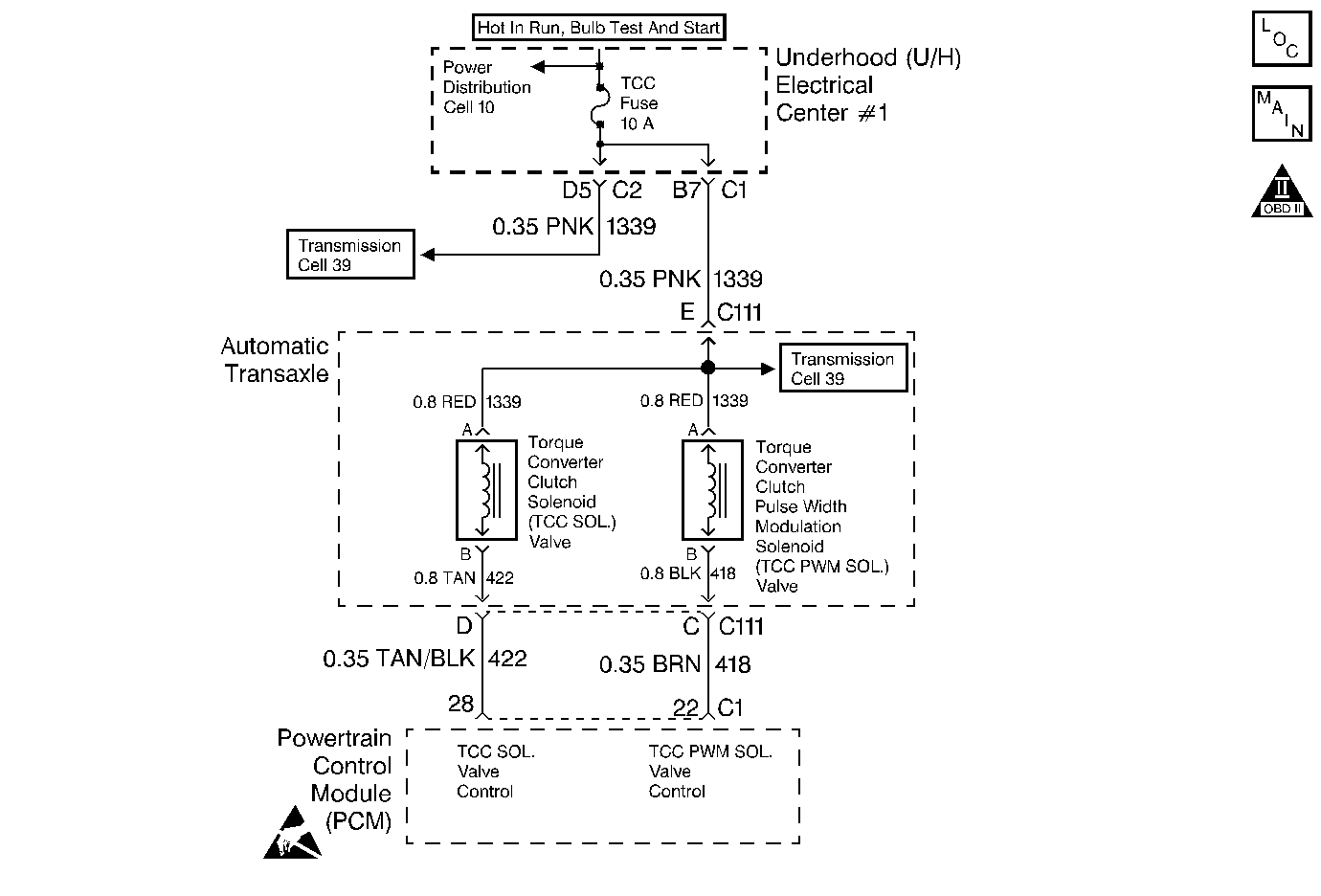
Circuit Description
The Torque Converter Clutch Pulse Width Modulation Solenoid Valve (TCC PWM Sol Valve) controls the fluid acting on the converter clutch valve. The converter clutch valve controls the application and the release of the TCC. When you command the TCC PWM Sol Valve OFF, the Powertrain Control Module (PCM) receives high voltage. When you command the TCC PWM Sol Valve ON, the PCM receives low voltage.
DTC P1860 sets anytime the received voltage is outside of the calibration limits. DTC P1860 is a type A DTC.
Conditions for Setting the DTC
| • | System voltage is 10-16 volts. |
| • | The engine speed is more than 500 RPM. |
| • | Not in fuel shut off. |
| • | The PCM commands the solenoid to greater than 90%, and circuit 418 voltage remains low (0 volts). |
| • | The PCM commands the solenoid to less than 10%, and circuit 418 voltage remains high (B+). |
All of the above conditions are met for 5 seconds.
Action Taken When the DTC Sets
| • | The PCM inhibits TCC operation. |
| • | The PCM inhibits 4th gear if the transmission is in the hot mode. |
| • | The PCM illuminates the Malfunction Indicator Lamp (MIL). |
Conditions for Clearing the MIL/DTC
| • | The PCM turns OFF the MIL after three consecutive ignition cycles without a failure reported. |
| • | A scan tool can clear the DTC from the PCM history. The PCM clears the DTC from the PCM history if the vehicle completes 40 warm-up cycles without a failure reported. |
| • | The PCM cancels the DTC default actions when the fault no longer exists and the ignition is OFF long enough in order to power down the PCM. |
Diagnostic Aids
- Inspect the wiring for poor electrical connections at the PCM. Inspect the wiring at the Automatic Transmission 7-way connector. Inspect the wiring at the 2-way TCC PWM Solenoid connector. Look for the following conditions:
- When diagnosing for an intermittent short or open condition, massage the wiring harness while watching the test equipment for a change.
- Ensure that the transmission fluid is at the proper level.
| • | A bent terminal |
| • | A backed out terminal |
| • | A damaged terminal |
| • | Poor terminal tension |
| • | A chafed wire |
| • | A broken wire inside the insulation |
Test Description
The numbers below refer to the step numbers on the diagnostic table.
-
This step isolates the engine harness from the transmission harness.
-
This step verifies that circuit 418 is not open or shorted to power.
-
This step verifies that the TCC PWM solenoid is not shorted across its windings or increased its resistance.
Step | Action | Value(s) | Yes | No | ||||||||||||||||
|---|---|---|---|---|---|---|---|---|---|---|---|---|---|---|---|---|---|---|---|---|
1 | Was the Powertrain On-Board Diagnostic (OBD) System Check performed? | -- | ||||||||||||||||||
2 |
Important: Before clearing the DTCs, use the scan tool in order to record the Freeze Frame and Failure Records for reference. The Clear Info function will erase the data. Did either one read Yes? | -- | Go to Diagnostic Aids | |||||||||||||||||
Is the test lamp OFF? | -- | |||||||||||||||||||
4 | Inspect circuit 418 for an open. Refer to Troubleshooting procedures, Section 8. Was a condition found and corrected? | -- | ||||||||||||||||||
Important: When the TCC PWM circuit is commanded ON, the test lamp will be OFF. When the TCC PWM circuit is commanded OFF, the test lamp will be ON. Does the solenoid cycle ON and OFF as commanded? | -- | |||||||||||||||||||
6 | Inspect circuit 418 for a short to ground. Refer to Troubleshooting Procedures, Section 8. Was a condition found and corrected? | -- | ||||||||||||||||||
7 | Inspect circuit 418 for a short to power. Refer to Troubleshooting Procedures, Section 8. Was a condition found and corrected? | -- | ||||||||||||||||||
Is the measured resistance within the specified range? | 10 ohms to 15 ohms | |||||||||||||||||||
9 | Is the resistance greater than the specified value? | 100 ohms | ||||||||||||||||||
10 | Inspect the RED wire circuit 1339 for an open. Inspect the BLK wire circuit 418 for an open. Refer to Troubleshooting Procedures, Section 8. Was a condition found and corrected? | -- | ||||||||||||||||||
11 | Connect a J 39200 Digital Multimeter (DMM) from terminal C of the jumper to ground. Is the measured resistance less than the specified value? | 100 ohms | ||||||||||||||||||
12 | Inspect the BLK wire circuit 418 for a short to ground. Refer to Troubleshooting Procedures, Section 8. Was a condition found and corrected? | -- | -- | |||||||||||||||||
13 | Replace the TCC PWM Sol. Valve. Refer to Solenoids and Wiring Harness, Section 7. Is the replacement complete? | -- | -- | |||||||||||||||||
14 | Inspect PCM connector C1 for bent, damaged or backed out connector pins. Was a condition found and corrected? | -- | ||||||||||||||||||
15 | Replace the PCM. Refer to Powertrain Control Module Replacement/Programming , Section 6. Is the replacement complete? | -- | -- | |||||||||||||||||
16 | In order to verify your repair, perform the following procedure:
Has the test run and passed? | -- | System OK |
